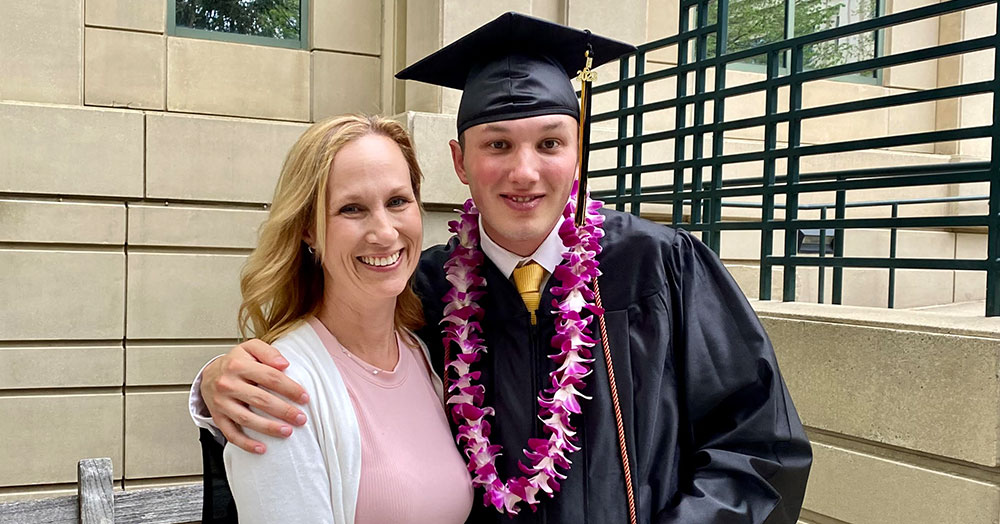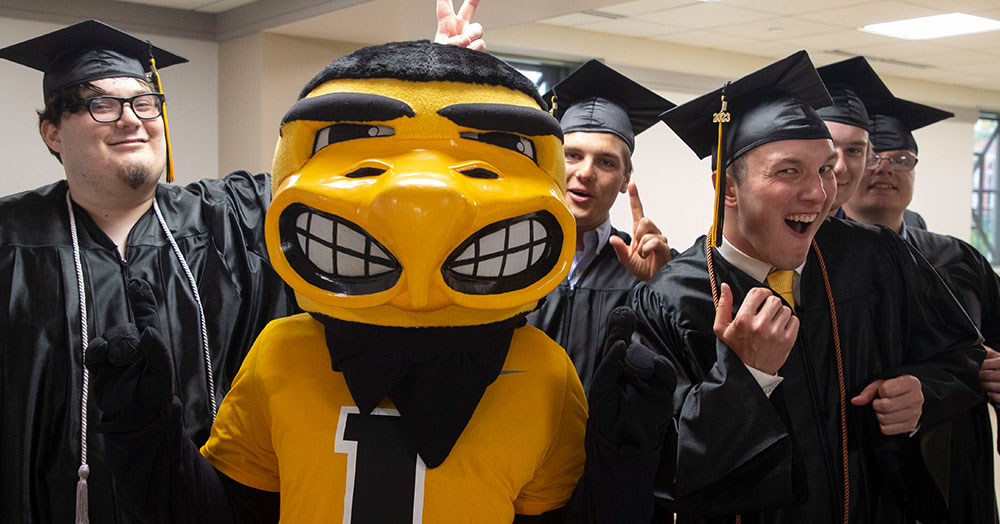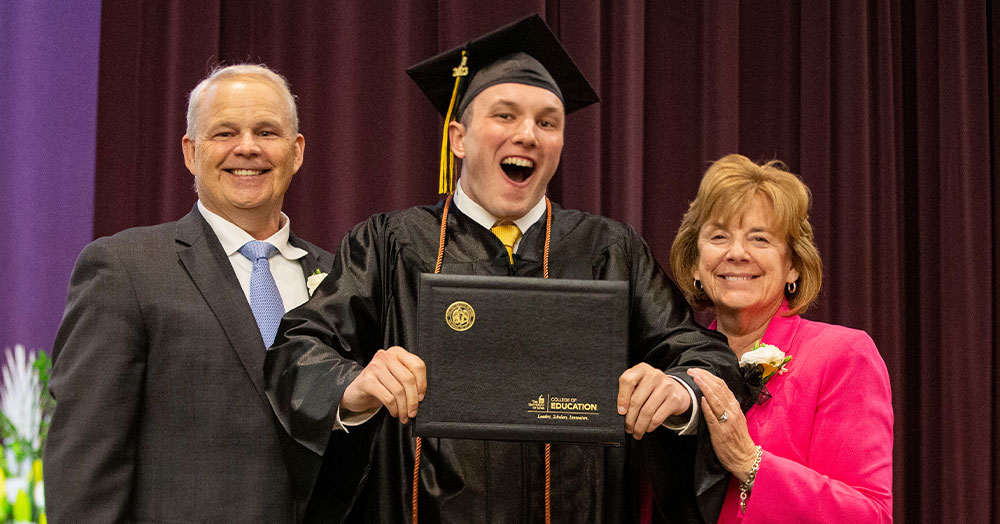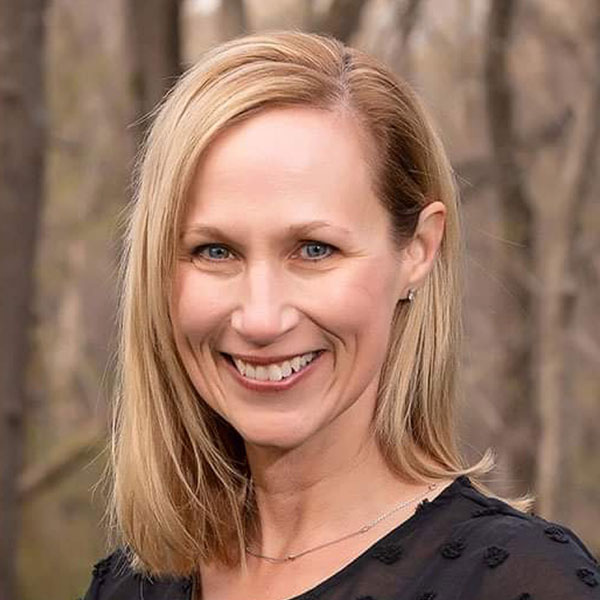Finding Peace is in Reach: An Autism Journey
 PHOTO COURTESY SUZANNE BARTLETT HACKENMILLER
Suzanne Bartlett Hackenmiller with her son, John, at his graduation from the UI REACH program this past spring
PHOTO COURTESY SUZANNE BARTLETT HACKENMILLER
Suzanne Bartlett Hackenmiller with her son, John, at his graduation from the UI REACH program this past spring
My 22-year-old son recently signed a lease for the new Iowa City apartment he’ll move into in August. As his guardian, technically I signed a lease. But John signed it too, in a ceremonial rite of passage.
It’s the time of year when young adults in college towns clamor for rental properties in an annual game of musical chairs. Sealing the deal is a challenge for anyone but, for John, two decades of hurdles preceded this day.
John was diagnosed with autism at 2 years and 9 months of age. A condition affecting language development, intellectual ability, and interactions with others, autism now affects an estimated 1 in 36 children in the United States. Twenty years ago, the prevalence was 1 in 150. Whereas autism centers now pepper the country, services were scant in 2003, which set the first row of hurdles for John.
Baby John’s big brown eyes locked with mine as he nestled into my lap, his tiny hand wrapped around my finger as we rocked in our glider. I said to myself, “Thank goodness he doesn’t have autism.” Having worked with students and patients on the autism spectrum, I thought our bond meant one of my maternal fears had been averted. Yet something about John seemed off: He was calmed by music and geometrical patterns, and he had precocious abilities (singing “The Star-Spangled Banner,” identifying octagons in everyday objects, counting to 10 in three languages, and pronouncing six-syllable words all before age 2), but conversation wasn’t developing. While other toddlers’ language improved and tantrums subsided, John’s tantrums worsened. If he wasn’t screaming, he was spinning a toy, a wheel, or himself.
As a physician, I knew about milestones. John landed on the far right-hand side of the developmental bell curve, so our pediatrician dismissed my concerns. But intuitively, I dug old pediatrics textbooks from my basement to search “language delay.” I was shocked to find—in each resource—the only diagnosis was autism. Early intervention professionals confirmed it.
When our options for services were to relocate or hire in-home professionals for $120,000 per year, our local autism team rose to the occasion and created a program for John that would later become the district’s special education preschool standard.
I have vivid memories of picking John up from preschool, of that solemn-faced little boy strapped in his booster in the back of my minivan.
“What did you do at school today, John?” I would ask.
“Friends,” he would say.
And that was it.
This was our dialogue day after day, and day after day, that was it.
“Friends,” he would say, just, “friends.”
Every day I would pray he could one day say more.
I would pray he would truly have friends.
Meanwhile, I bought toys—too many toys—in my quest to stimulate John. If a toy or video was educational and kept his attention, I bought it. As John got older, I struggled to find age-appropriate playthings. One of my victories was a VHS tape called Animusic. The video showed animated robotic instruments in whimsical rock bands and symphonies. It was inspiring, innovative brilliance, and John loved it.
The 2000s was the decade of autism awareness and fundraising to cure autism. Documentaries depicting dismal lives with children on the autism spectrum arose. Our family volunteered, walked, ran, and bicycled in charity events. We attended a Hollywood gala and shared the red (well, blue for autism) carpet with celebrities Jerry Seinfeld, Ed Asner, and Paul Simon. At another event, former President Bill Clinton noticed my autism hat and stopped. He believed stem cell therapy would cure autism during my son’s lifetime. Maybe it will. Maybe it won’t.
But over time, the fervor to cure autism gave way to a movement of acceptance—a realization that human existence, itself, is a spectrum. It was acknowledged that people with autism could (and deserved to) live and thrive like everyone else.
An early advocate was Sally Pederson, former lieutenant governor of Iowa and the mother of a son with autism. Seared into my memory is her 2005 presentation at the Autism Society of Iowa, where she shared her son’s experiences at an Illinois college. She pressed for the creation of a similar program at the University of Iowa, later named UI REACH, for Realizing Educational and Career Hopes. This gave me hope.
But my hope faded over time. Secondary school meant fewer services, special education budget cuts, and Individual Education Plans that seemed not-so-individual. I became “that parent” who often lost but always fought for more. The district and I seemed to be on two different tracks, and the hurdles just kept growing higher.
Then, in John’s senior year, post-graduation talks started. I had this niggling voice in my head: Remember UI REACH? It dangled like a carrot in the back of my mind, a what-if. But as I considered John’s progress, it seemed unattainable. John’s language remained stilted; how could he manage an interview? John needed help crossing the street; how could he navigate campus?
That little voice was stifled and weary but deep in my head whispered, “Go!” So, in the eleventh hour, John and I visited the UI REACH program in Iowa City. Faculty members expressed optimism and noted qualities I took for granted: John did our laundry, loved to vacuum, drove a riding lawnmower, and was polite, kind, and courteous. They encouraged him to apply. They rekindled hope.
So, we applied.
And we waited.
And John interviewed.
And John was accepted.
 PHOTO COURTESY SUZANNE BARTLETT HACKENMILLER
John (at right) celebrates his graduation this past spring from the UI REACH program with Herky and friends.
PHOTO COURTESY SUZANNE BARTLETT HACKENMILLER
John (at right) celebrates his graduation this past spring from the UI REACH program with Herky and friends.
UI REACH is a two-year program with an optional extension. Students live in residence halls alongside traditional undergrads for two years and spend additional years in an on-campus apartment. They take UI REACH-specific courses and are encouraged to audit or complete community college or university courses, if appropriate. Students enjoy social activities each week and learn independent living and job skills. Internships are tailored to their interests, and students graduate with a certificate of completion. UI REACH is a model of excellence, a prototype for others to emulate.
John moved into the dorms in August 2019. Despite the program’s many safety features, I suffered weeks of hair-graying stress. I’ll admit I tracked my kid electronically at first, fearing he would be hit by a car, lost, abducted, or worse. In week two, John called me in a panic, lost on campus. I was about to give a large work presentation, but technology allowed me to locate and reroute him, and get both of us breathing again.
A month later, my husband, Joe, and I visited John and took him out for lunch. We planned to drop him off on our way home.
“That’s OK,” John said. “I can walk.”
Joe and I were in disbelief as John blended in with the crowd, strolled down the sidewalk, crossed at the light, and walked the six blocks to his dorm. My anxiety lifted like a hot air balloon.
“He’s got this,” Joe said with a grin.
John has now completed three years of UI REACH (plus a COVID gap year). He expressed his desire to live in Iowa City after his spring graduation, but I couldn’t see how it could work. However, the universe conspired with John’s circle of support, and a friend had a friend who had apartments for rent. He found a roommate and support services, and things seemed to fall into place.
In May, John finished a paid internship in production at Procter & Gamble and accepted an offer to return after graduation. He knows how to navigate the campus and city buses to get to his job—a fact that still blows my mind. He loves the constancy and repetition of the production line, I believe, and watching the line’s robots at work makes his day.
“It’s my dream job, Mom,” he says.
John works out at the gym most days and buys himself a treat on payday. He enjoys hanging out with friends, who, it seems, are everywhere. Joe and I are amazed at how often we bump into friends—REACH and traditional college students alike—in restaurants, around town, and at airports in two different cities who tell us they know and love John.
 PHOTO COURTESY SUZANNE BARTLETT HACKENMILLER
UI College of Education Dean Daniel L. Clay and UI President Barbara Wilson pose with John as he receives his diploma from the UI REACH program.
PHOTO COURTESY SUZANNE BARTLETT HACKENMILLER
UI College of Education Dean Daniel L. Clay and UI President Barbara Wilson pose with John as he receives his diploma from the UI REACH program.
In 2010, I was asked to lead a discussion on the Dalai Lama’s book, The Art of Happiness, correlating with a visit to our community from His Holiness. In preparation, I read numerous books on the spiritual leader. The challenges of work burnout, my late husband Dave’s terminal cancer, and raising two young kids often made me contemplate the purpose and meaning of life.
“The very purpose of life is to be happy,” the Dalai Lama is quoted as saying. “The key is to develop inner peace.”
“Is that really it?” I have wondered.
Is the purpose of life to find happiness and joy?
To develop inner peace?
That’s it?
And how do you know when you’ve found it?
Remember that old VHS tape, Animusic? You can now stream it; my son happens to know. Home on his final spring break this past year, he asks me to watch it with him. Twenty-two years of memories wash over me as I sit on the sofa with John, pure joy igniting his face. Blinking back tears, I am flooded with gratitude for the village of people who have always been there for him. I picture that little boy in the back seat whom I’d prayed for. I reflect on his progress, his independence, his apartment, his friends, his job, and his ability, now, to sit on the couch and chat. I see peace in my son like never before—inner peace.
I realize I have it too.
“Look, Mom,” John says. “There are robots like this at my job.”

Suzanne Bartlett Hackenmiller (96MD) is an OB-GYN and integrative medicine physician, author, wife, and mother. She divides her time between Iowa and Arizona.
This piece was originally published on her blog, Integrative Initiative, and republished here with permission.
